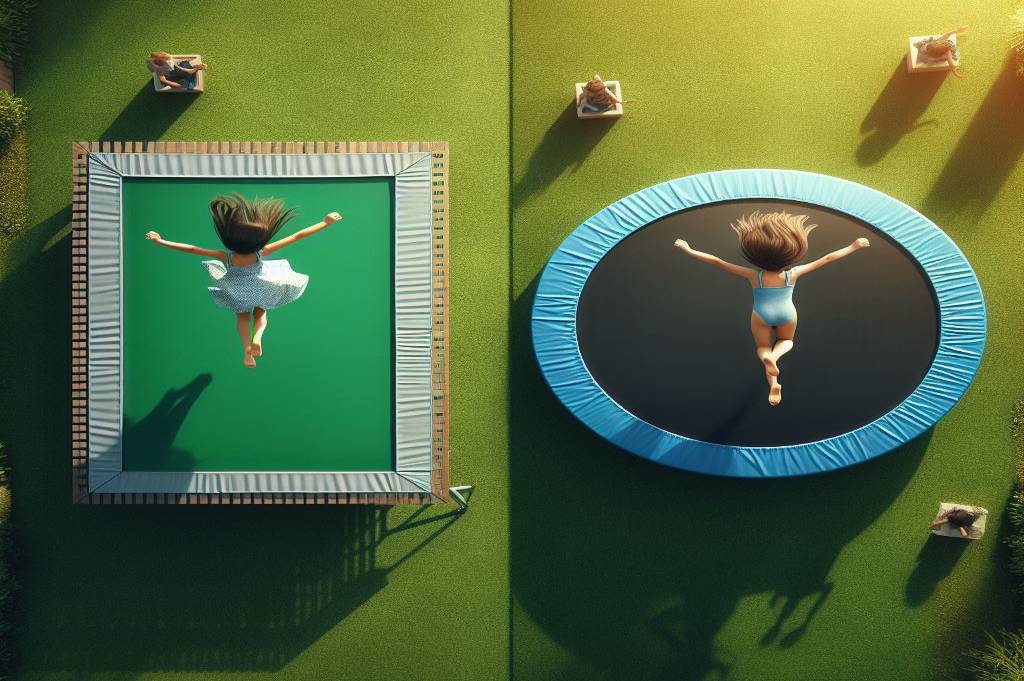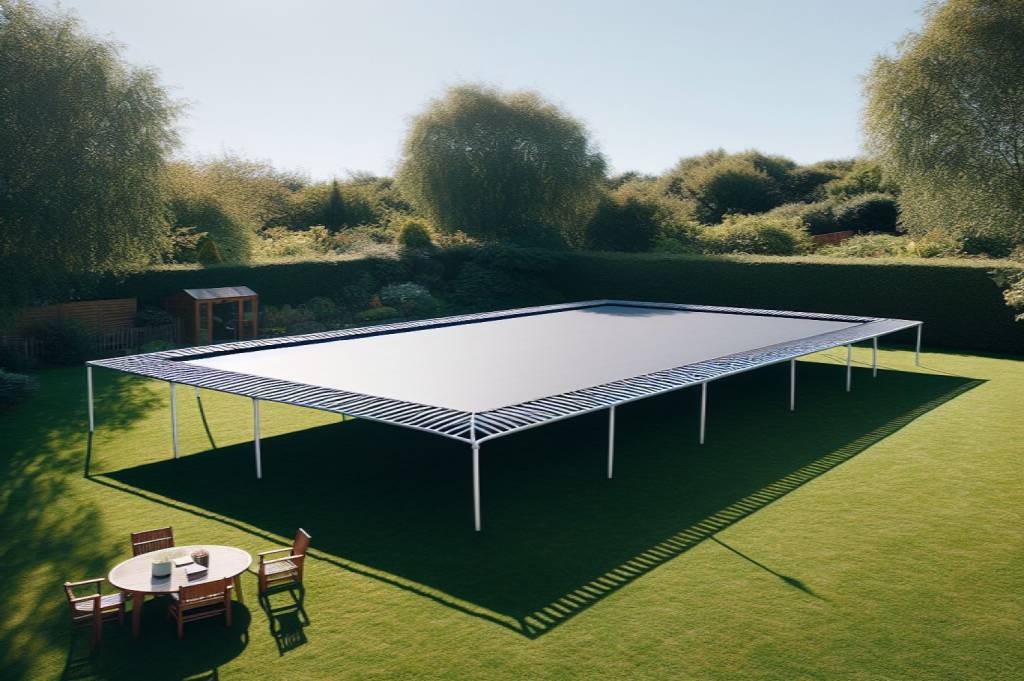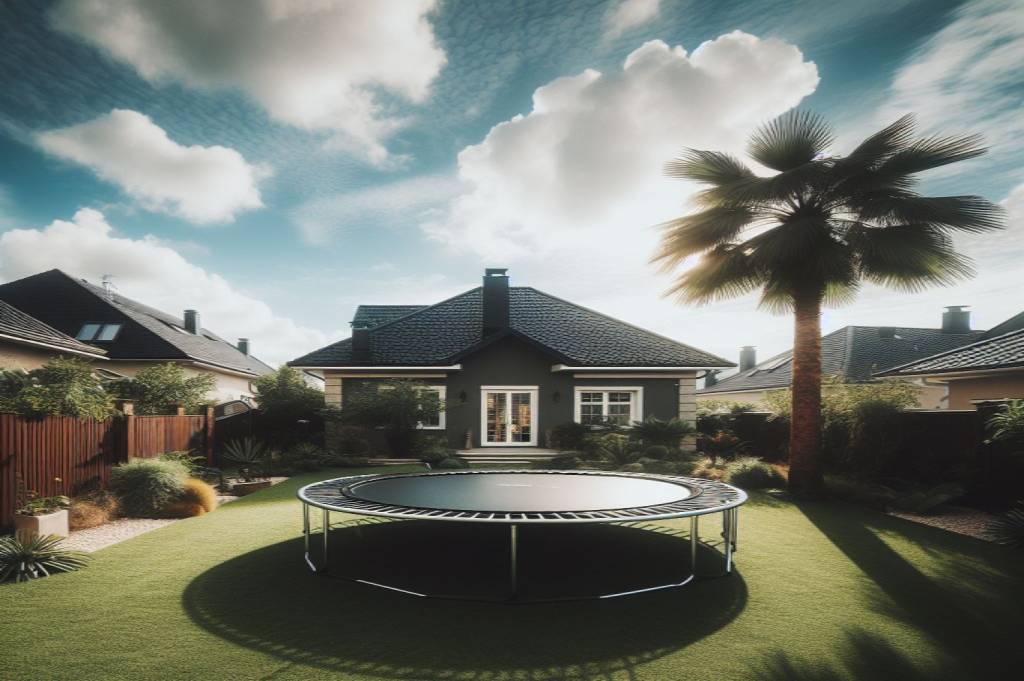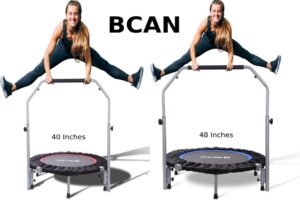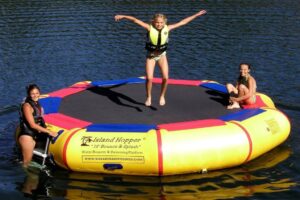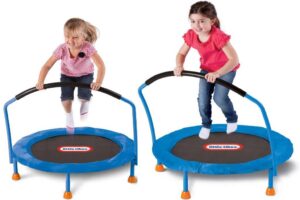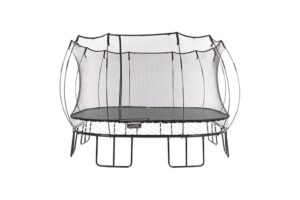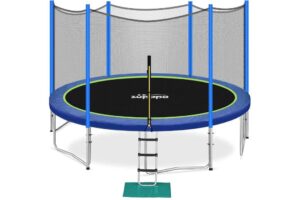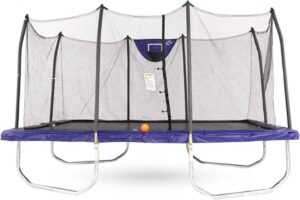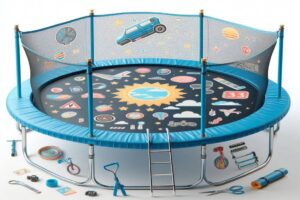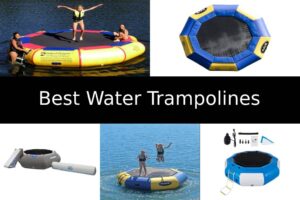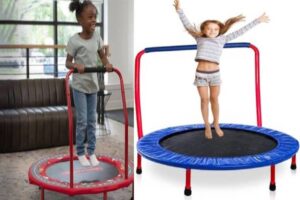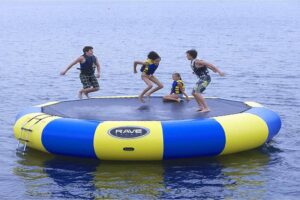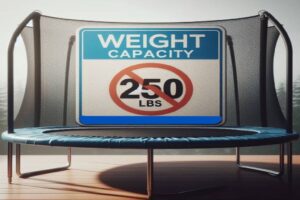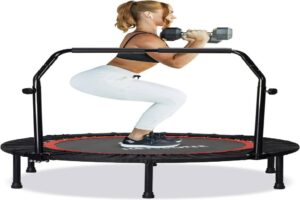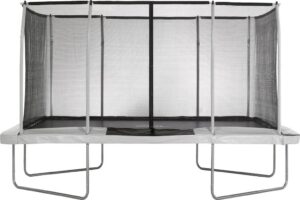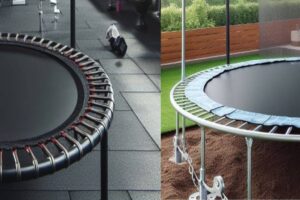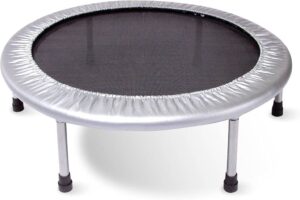Introduction
Rectangular Trampoline vs. Round Trampoline
Trampolines have long been cherished as quintessential pieces of recreational equipment, offering boundless fun and exhilarating experiences for both children and adults alike. These devices, characterized by their elasticized fabric stretched across a sturdy frame, have evolved from simple backyard novelties to sophisticated apparatuses that cater to various needs and preferences. As we embark on comparing the merits of rectangular trampoline vs. round trampoline, it’s essential to understand their fundamental role in recreation and leisure.
Trampolines, with their origins dating back to the early 20th century, were initially conceived for acrobatic training and military purposes. However, their popularity surged in the latter half of the century, transitioning into beloved fixtures of backyard entertainment and professional sports training.
These devices consist of a sturdy frame typically made of steel, supporting a stretched fabric or synthetic material known as the jumping mat. Springs or elastic bands secure the mat to the frame, providing the necessary tension for bouncing. Trampolines come in various shapes and sizes, rectangular trampolines and round trampolines being among the most popular options.
In today’s market saturated with options, choosing the right trampoline can be a daunting task. This comparison between rectangular trampoline vs. round trampoline aims to alleviate the confusion and empower buyers with the knowledge needed to make informed decisions.
Understanding the unique characteristics and features of rectangular trampoline vs. round trampoline allows prospective buyers to assess their specific needs and preferences. Whether prioritizing bounce quality, safety features, space constraints, or budget considerations, this comparison serves as a comprehensive guide to navigating the plethora of options available.
By dissecting the nuances between rectangular trampoline vs. round trampoline, we aim to shed light on their respective strengths and limitations. Ultimately, our goal is to equip buyers with the insights necessary to select the trampoline that best suits their individual requirements, ensuring countless hours of safe and enjoyable bouncing for years to come.
In the next parts, we will delve deeper into the design, bounce quality, safety features, space requirements, pricing, durability, and user experience of rectangular trampoline vs. round trampoline. Through a thorough examination of these factors, readers will gain a holistic understanding of each trampoline type, facilitating a well-informed purchasing decision.
Design and Shape
Rectangular Trampoline vs. Round Trampoline
When it comes to choosing the perfect trampoline for your backyard or recreational space, understanding that the design and shape which differentiate rectangular trampoline vs. round trampoline is crucial. Each shape offers distinct features and benefits, catering to different preferences and activities.
Description of Rectangular Trampolines
Rectangular trampolines are characterized by their elongated shape, featuring straight edges and angular corners. These trampolines often mimic the design of professional gymnastic trampolines, making them popular among athletes and those seeking precise and controlled bouncing experiences.
The design of rectangular trampolines allows for consistent bounce across the entire surface, making them ideal for performing tricks, flips, and other advanced manoeuvres. The springs on Rectangular Trampolines are typically positioned along the longer sides, providing greater tension and responsiveness compared to round trampolines.
Description of Round Trampolines
Round trampolines, on the other hand, feature a circular shape with a central bouncing area. These trampolines are the most common and widely recognized shape among recreational users. round trampolines offer a softer and more forgiving bounce, making them suitable for children, families, and casual jumpers.
The design of round trampolines distributes the tension evenly throughout the jumping surface, resulting in a consistent bounce regardless of where the jumper lands. The springs on round trampolines are arranged in a radial pattern, providing stability and balance during bouncing sessions.
Pros and Cons of Each Shape
Both rectangular and round trampolines have their own set of advantages and disadvantages, which should be carefully considered before making a purchase decision.
Rectangular Trampoline:
Pros
- Ideal for advanced jumpers and gymnasts due to their responsive bounce and larger jumping surface.
- Provide better control and stability for performing tricks and flips.
- Can accommodate multiple jumpers simultaneously without affecting the bounce quality.
Cons
- Typically, more expensive than round trampolines due to their specialized design and construction.
- Require more space in the backyard or recreational area due to their elongated shape.
- May pose higher safety risks if not used properly, especially for inexperienced jumpers.
Round Trampoline:
Pros
- Suitable for users of all ages and skill levels, making them perfect for family entertainment.
- Offer a softer and more forgiving bounce, reducing the risk of injury during play.
- Take up less space compared to rectangular trampolines, making them ideal for smaller yards or limited outdoor spaces.
Cons
- Less responsive bounce compared to rectangular trampolines, limiting the ability to perform advanced tricks.
- Can experience slight distortion in bounce near the edges due to the radial spring arrangement.
- May have lower weight limits compared to rectangular trampolines, limiting the number of users and activities.
In conclusion, comparing rectangular trampoline vs. round trampoline ultimately depends on your specific needs, preferences, and intended use. Whether you prioritize precision and control or versatility and family fun, understanding the design and shape differences between these trampoline types will help you make an informed decision that best suits your recreational needs.
Bounce Quality
Rectangular Trampoline vs. Round Trampoline
One of the most critical factors to consider when comparing rectangular trampoline vs. round trampoline is bounce quality. The way these trampolines deliver the bounce experience varies significantly, impacting everything from recreational enjoyment to athletic training. Here, we’ll explore how bounce differs between Rectangular and Round Trampolines, the factors influencing bounce quality, and which shape offers the better bounce for different types of activities.
How Bounce Differs Between Rectangular and Round Trampolines
The bounce experience on a rectangular trampoline differs markedly from that on a round trampoline. Rectangular trampolines are renowned for providing a consistent and powerful bounce across the entire jumping surface. Their elongated shape and arrangement of springs along the longer sides contribute to this responsive and controlled bounce.
Whether you’re practicing gymnastic manoeuvres or perfecting your aerial tricks, rectangular trampolines offer the stability and rebound needed for precise and dynamic movements
On the other hand, round trampolines offer a softer and more forgiving bounce. The circular design and radial arrangement of springs distribute the tension evenly, resulting in a gentler rebound that’s ideal for recreational bouncing and family fun.
While round trampolines may not offer the same level of precision and control as their rectangular counterparts, they provide a safe and enjoyable bouncing experience for users of all ages and skill levels.
Factors Affecting Bounce Quality
Several factors influence the bounce quality of both rectangular and round trampolines:
Spring Tension: The tension and distribution of springs play a significant role in determining bounce quality. Rectangular trampolines typically have higher tension springs along the longer sides, offering a more responsive bounce, while round trampolines feature evenly distributed tension for a consistent rebound.
Frame Stability: The stability and rigidity of the trampoline frame affect the bounce performance. Rectangular trampolines often feature heavier-duty frames to support the increased tension and provide a stable platform for advanced manoeuvres.
Jumping Mat Material: The quality and elasticity of the jumping mat impact the bounce experience. High-quality materials that offer durability and elasticity contribute to a more enjoyable and responsive bounce.
User Weight and Skill Level: The weight of the user and their skill level also influence bounce quality. Heavier users may experience a deeper bounce, while lighter users may find it easier to control their movements on the trampoline.
Which Shape Offers Better Bounce for Different Types of Activities
The choice between rectangular and round trampolines ultimately depends on the type of activities you plan to engage in:
Rectangular trampolines: Ideal for activities that require precise control and dynamic movements, such as gymnastics, tumbling, and tricking. The responsive bounce and larger jumping surface make rectangular trampolines the preferred choice for athletes and advanced jumpers seeking performance and versatility.
Round trampolines: Suited for recreational bouncing, family play, and general fitness activities. The softer and more forgiving bounce of Round Trampolines provides a safe and enjoyable experience for users of all ages and skill levels, making them perfect for backyard entertainment and group gatherings.
In conclusion, both rectangular and round trampolines offer unique bounce experiences tailored to different preferences and activities. Whether you prioritize precision and performance or safety and versatility, understanding the factors influencing bounce quality will help you choose the trampoline shape that best suits your needs and enhances your bouncing enjoyment.
Safety
Rectangular Trampoline vs. Round Trampoline
Ensuring the safety of users is paramount when it comes to selecting the right trampoline for your home or recreational space. Rectangular Trampolines and Round Trampolines both offer unique safety features designed to minimize the risk of accidents and injuries. Here, we’ll explore the safety features of each trampoline shape and compare the injury risks associated with rectangular trampoline vs. round trampoline.
Safety Features of Rectangular Trampolines
Rectangular trampolines often come equipped with advanced safety features to mitigate potential risks:
- Enclosure Netting: Many rectangular trampolines include enclosure netting that surrounds the entire jumping area, preventing users from falling off the trampoline onto the ground.
- Reinforced Frame: The sturdy frame construction of rectangular trampolines provides added stability and support, reducing the likelihood of the trampoline tipping over during use.
- Spring Cover Padding: Rectangular trampolines typically feature thick and durable padding covering the springs and frame edges, minimizing the risk of users meeting hard surfaces.
- High Weight Capacity: Rectangular trampolines often have higher weight capacities compared to round trampolines, allowing for multiple users to safely bounce simultaneously.
Safety Features of Round Trampolines
Round trampolines also offer various safety features designed to enhance user protection:
- Enclosure Netting: Like rectangular trampolines, many round trampolines come with enclosure netting to prevent users from falling off the trampoline.
- Soft Edge Padding: Round trampolines feature soft and thick padding covering the frame edges, reducing the risk of injury from accidental impacts.
- Centralized Bounce: The circular design of round trampolines directs users towards the center of the jumping surface, minimizing the risk of falling off the trampoline.
- Weather Resistance: Many round trampolines are constructed with weather-resistant materials, ensuring durability and safety even in outdoor environments.
Comparison of Injury Risks Associated with Rectangular Trampoline vs. Round Trampoline
While both rectangular and round trampolines offer safety features to protect users, there are differences in the injury risks associated with each shape:
Rectangular trampolines: The elongated shape of rectangular trampolines may pose a higher risk of users colliding with the frame or springs, especially during high-impact activities such as gymnastics or tricking.
Round trampolines: The centralized bounce of round trampolines reduces the risk of users being propelled towards the edges, minimizing the chance of falling off or hitting the frame. However, users may still collide with each other in the center of the trampoline.
In conclusion, both rectangular and round trampolines offer safety features to mitigate injury risks, but there are differences in these risks associated with each shape. Understanding these distinctions can help users make informed decisions to ensure a safe and enjoyable bouncing experience for themselves and their families.
Space and Placement
Rectangular Trampoline vs. Round Trampoline
When it comes to choosing between a rectangular trampoline and a round trampoline, one crucial factor to consider is the space available for installation. Both trampoline shapes have different space requirements, and understanding these requirements is essential for ensuring a safe and enjoyable bouncing experience. Here, we’ll explore the space requirements for rectangular trampoline vs. round trampoline and provide considerations for placement in your backyard or indoor space.
Space Requirements for Rectangular Trampolines
Rectangular trampolines typically require more space than their round counterparts due to their elongated shape:
Length and Width: Rectangular trampolines come in various sizes, but even the smallest models require a considerable amount of space. The length of a Rectangular Trampoline can range from 8 feet to over 15 feet, while the width typically ranges from 6 feet to 10 feet.
Clearance: In addition to the dimensions of the trampoline itself, it’s essential to allow for clearance around the trampoline to ensure safety. A minimum clearance of 2-3 feet on all sides is recommended to prevent users from accidentally hitting obstacles or structures.
Orientation: Rectangular trampolines should ideally be placed in a horizontal orientation, with the longer sides facing parallel to the ground. This orientation maximizes the available jumping space and allows for safer and more controlled bouncing.
Space Requirements for Round Trampolines
Round trampolines generally require less space than rectangular trampolines due to their circular design:
Diameter: Round trampolines typically come in sizes ranging from 8 feet to 15 feet in diameter. The smaller diameter compared to rectangular trampolines means that round trampolines can fit into tighter spaces more easily.
Clearance: Like rectangular trampolines, it’s essential to provide adequate clearance around a Round Trampoline to ensure safety. A minimum clearance of 2-3 feet on all sides is recommended to prevent accidents and injuries.
Orientation: Round trampolines should be placed with the circular frame parallel to the ground. This orientation ensures a consistent bounce experience and minimizes the risk of users falling off the trampoline.
Considerations for Placement in Your Backyard or Indoor Space
When determining the placement of your trampoline, whether rectangular or round, consider the following factors:
Level Ground: Ensure that the chosen location is level and free from any slopes or uneven terrain. A level surface is essential for stability and safety during use.
Clearance: Provide ample clearance around the trampoline to prevent collisions with obstacles, structures, or vegetation. Remove any debris or hazards from the surrounding area to create a safe bouncing environment.
Sunlight Exposure: Consider the amount of sunlight exposure in the chosen location. While some sunlight is beneficial for outdoor enjoyment, excessive exposure can cause the trampoline materials to degrade over time. Choose a spot that offers a balance of sunlight and shade throughout the day.
Accessibility: Ensure easy access to the trampoline from all sides, especially if it will be used by children. Clear pathways leading to and from the trampoline to prevent tripping hazards and accidents.
By carefully considering the space requirements and placement considerations for rectangular trampoline vs. round trampoline, you can create a safe and enjoyable bouncing environment in your backyard or indoor space. Whether you have ample outdoor space or limited room to spare, there’s a trampoline shape and size to suit your needs and preferences.
Price and Affordability
Rectangular Trampoline vs. Round Trampoline
When considering purchasing a trampoline, understanding the price differences between rectangular trampolines and round trampolines is essential. Both shapes come with their own set of features and benefits, which can influence their respective costs. Here, we’ll delve into the cost comparison between rectangular trampoline vs. round trampoline, exploring the factors that influence the price difference, and discuss long-term value and investment considerations.
Cost Comparison: Rectangular Trampoline vs. Round Trampoline
Rectangular trampolines generally tend to be more expensive than round trampolines due to several factors:
Specialized Design: Rectangular trampolines are often designed with features tailored to advanced jumping and gymnastic maneuvers, such as higher tension springs and a larger jumping surface. This specialized design requires more materials and precision manufacturing, resulting in a higher price tag.
Construction Materials: The materials used in the construction of rectangular trampolines are typically of higher quality and durability compared to those used in round trampolines. This can include heavier-duty frames, thicker padding, and more robust jumping mats, all of which contribute to increased production costs.
Brand and Reputation: Certain brands may command higher prices based on their reputation for quality, safety, and innovation. Rectangular trampolines from well-known manufacturers may carry a premium price due to their established brand recognition and customer trust.
Size and Features: Larger rectangular trampolines with additional features, such as enclosure nets, ladder access, and weather-resistant materials, will naturally cost more than smaller or basic models.
Factors Influencing the Price Difference
Several factors contribute to the price difference between Rectangular and Round Trampolines:
Size: The size of the trampoline, regardless of shape, is a significant determinant of price. Larger trampolines typically cost more than smaller ones due to the increased materials and manufacturing costs.
Quality of Materials: The quality of materials used in construction, including the frame, springs, jumping mat, and padding, can impact the price. Trampolines made from high-quality, durable materials may have a higher upfront cost but offer better long-term value.
Safety Features: Trampolines with advanced safety features, such as enclosure nets, reinforced frames, and thick padding, may command a higher price due to the additional engineering and materials required.
Brand Reputation: Established brands with a history of producing reliable and safe trampolines may charge a premium for their products compared to lesser-known brands.
Long-term Value and Investment Considerations
While rectangular trampolines may have a higher initial cost compared to round trampolines, they may offer better long-term value and durability:
Durability: Rectangular trampolines are often constructed from higher-quality materials and are built to withstand rigorous use over time. Investing in a durable trampoline upfront can save money on repairs and replacements in the long run.
Versatility: The specialized design of rectangular trampolines makes them suitable for a wide range of activities, including gymnastics, tumbling, and tricking. Their versatility allows users to engage in advanced maneuvers and athletic training, providing added value for enthusiasts.
Safety: While both rectangular and round trampolines prioritize safety, the sturdier construction and larger jumping surface of rectangular trampolines may offer added peace of mind for users, especially during high-impact activities.
In conclusion, while rectangular trampolines may come with a higher upfront cost compared to round trampolines, they offer unique features and benefits that justify the investment for certain users. By considering factors such as size, quality, safety features, and long-term value, buyers can make an informed decision that aligns with their budget and recreational needs. Ultimately, investing in a quality trampoline that provides years of enjoyment and safety for the whole family is a worthwhile investment.
Durability and Maintenance
Rectangular Trampoline vs. Round Trampoline
When investing in a trampoline, durability and maintenance are key factors to consider. Both rectangular trampolines and round trampolines offer different levels of durability and maintenance requirements, which can impact their longevity and overall value. Here, we’ll compare the durability of rectangular trampoline vs. round trampoline, discuss their maintenance requirements, and explore their lifespan and potential repair costs.
Durability of Rectangular Trampoline vs. Round Trampoline
Rectangular trampolines are often considered more durable than round trampolines due to their construction and design:
Frame Construction: Rectangular trampolines typically feature heavier-duty frames made of sturdy materials such as galvanized steel. This robust construction provides greater stability and resistance to wear and tear over time.
Spring Configuration: The arrangement of springs along the longer sides of rectangular trampolines distributes weight more evenly, reducing stress on individual components and enhancing overall durability.
Jumping Surface: Rectangular trampolines offer a larger and more consistent jumping surface compared to round trampolines, resulting in less strain on the frame and springs during use.
Round trampolines, while generally less durable than rectangular trampolines, still offer reliable performance when properly maintained:
Frame Design: Round trampolines feature a circular frame that may be more prone to deformation and warping over time compared to the rectangular frame of rectangular trampolines.
Spring Placement: The radial placement of springs on round trampolines can create uneven stress distribution, potentially leading to premature wear and tear on certain components.
Jumping Surface: Round trampolines may experience slight distortion in the jumping surface over time, especially near the edges, which can affect bounce quality and durability.
Maintenance Requirements for Each Shape
Both rectangular and round trampolines require regular maintenance to ensure optimal performance and safety:
Cleaning: Regularly clean the jumping mat, frame, and springs of the trampoline to remove dirt, debris, and moisture that can cause premature deterioration.
Inspection: Periodically inspect the frame, springs, and padding for signs of wear, damage, or corrosion. Replace any worn or damaged components to maintain the trampoline’s structural integrity.
Tightening: Check the tension of springs and bolts regularly and tighten as needed to prevent loosening and instability during use.
Weather Protection: Protect the trampoline from harsh weather conditions, such as rain, snow, and prolonged exposure to sunlight, which can accelerate deterioration. Use a weather cover or store the trampoline indoors when not in use.
Lifespan and Potential Repair Costs
The lifespan of a trampoline depends on various factors, including its quality, usage, and maintenance:
Rectangular Trampolines: With proper care and maintenance, rectangular trampolines can last anywhere from 5 to 10 years or more. While they may have a higher upfront cost, their durability and longevity justify the investment.
Round Trampolines: Round trampolines typically have a shorter lifespan compared to rectangular trampolines, averaging 3 to 7 years with proper maintenance. Repair costs for round trampolines may be lower than for rectangular trampolines due to their simpler design and construction.
Potential repair costs for both rectangular and round trampolines may include replacement of springs, padding, or the jumping mat, as well as repairs to the frame or enclosure netting. It’s essential to budget for these potential expenses and invest in quality replacement parts when necessary to prolong the trampoline’s lifespan and ensure continued safety and enjoyment.
In conclusion, both rectangular trampolines and round trampolines offer durable and reliable performance when properly maintained. While rectangular trampolines may have a longer lifespan and higher upfront cost, they provide superior durability and stability, making them a worthwhile investment for families and enthusiasts seeking long-term enjoyment and safety.
User Experience and Preferences
Rectangular Trampoline vs. Round Trampoline
The user experience and personal preferences play a significant role in determining the ideal trampoline shape for individual needs. Feedback from users of both Rectangular Trampolines and Round Trampolines provides valuable insights into the strengths and considerations of each shape. Here, we’ll explore the feedback from users of both trampoline shapes and discuss personal preferences and considerations based on individual needs.
Feedback from Users of Rectangular and Round Trampolines
Users of rectangular trampolines often praise their performance and versatility:
- Athletic Enthusiasts: Athletes and gymnasts appreciate the larger jumping surface and responsive bounce of rectangular trampolines, which allow for advanced maneuvers and precise control during training sessions.
- Families: Families with multiple users appreciate the spaciousness of rectangular trampolines, which accommodate multiple jumpers simultaneously without compromising bounce quality.
- Safety Conscious: Users value the sturdy construction and stability of rectangular trampolines, which provide added peace of mind during high-impact activities and vigorous bouncing.
Users of round trampolines also have positive feedback regarding their experience:
- Recreational Fun: Families and casual users enjoy the soft and forgiving bounce of round trampolines, which makes for a fun and enjoyable bouncing experience for users of all ages.
- Space Efficiency: Users with limited outdoor space appreciate the compact design of round trampolines, which fit easily into smaller yards or indoor spaces without sacrificing bounce quality.
- Easy Setup: Many users find round trampolines easier to set up and assemble compared to rectangular trampolines, making them a convenient choice for those seeking hassle-free installation.
Personal Preferences and Considerations Based on Individual Needs
When choosing between rectangular and round trampolines, personal preferences and considerations based on individual needs play a crucial role:
Activity Level: For users engaged in high-intensity activities such as gymnastics or tricking, a rectangular trampoline may offer superior performance and control. However, for recreational bouncing and family fun, a round trampoline may be more suitable.
Available Space: The amount of available outdoor or indoor space can influence the choice of trampoline shape. Rectangular trampolines require more space due to their elongated design, while round trampolines are more space-efficient.
Budget: Budget constraints may also impact the choice of trampoline shape, as rectangular trampolines tend to be more expensive than round trampolines due to their specialized design and construction.
User Preferences: Ultimately, personal preferences such as bounce quality, size, and aesthetic appeal should be considered when selecting the ideal trampoline shape. Users should choose the shape that aligns with their preferences and usage requirements to ensure a satisfying and enjoyable bouncing experience.
In conclusion, the user experience and preferences vary between rectangular trampolines and round trampolines, with each shape offering unique advantages and considerations. By considering factors such as activity level, available space, budget, and personal preferences, users can select the trampoline shape that best suits their needs and enhances their bouncing enjoyment. Whether seeking high-performance capabilities or family-friendly fun, there’s a trampoline shape to accommodate all user’s preferences and requirements.
Conclusion
Rectangular Trampoline vs. Round Trampoline
After an in-depth comparison between rectangular trampoline vs. round trampoline, it’s evident that each shape offers unique benefits and considerations, catering to different user preferences and needs.
Rectangular trampolines stand out for their elongated shape, which provides a larger jumping surface and facilitates a more controlled and precise bounce. This design makes rectangular trampolines the preferred choice for athletes and advanced users who prioritize performance and precision during activities like gymnastics, tumbling, and tricking. The consistent bounce across the entire surface of rectangular trampolines ensures stability and enables users to execute intricate maneuvers with confidence and control. Although rectangular trampolines may come with a higher upfront cost, their superior durability and long-term value make them a worthwhile investment for enthusiasts seeking a premium bouncing experience.
In contrast, round trampolines feature a circular design that appeals to families and recreational users seeking versatile and enjoyable bouncing experiences. The rounded shape of round trampolines ensures an even distribution of tension and a soft, forgiving bounce, making them suitable for users of all ages and skill levels. Round trampolines offer a budget-friendly option without compromising on safety or fun, making them an excellent choice for families with children or casual users looking to enjoy backyard bouncing activities.
Ultimately, the decision between rectangular trampoline vs. round trampoline hinges on individual preferences, usage requirements, and available space. Athletes and advanced users seeking precision and performance may opt for rectangular trampolines, while families and recreational users looking for versatility and family fun may prefer round trampolines.
Whether you’re looking for high-performance capabilities, family-friendly fun, or something in between, there’s a trampoline shape out there to suit your needs and enhance your bouncing enjoyment. Happy bouncing!
Related posts:
- Indoor vs. Outdoor Trampolines: Dominate Your Bounce
- Trampoline Safety Tips – Jumping for Joy without the Risk
- Trampoline Assembly Excellence: Your Comprehensive Step-by-Step Guide to Bouncing Bliss!
- Trampoline Hole Repair Guide: Masterful Fixes for Unleashing Bouncing Power!
- Trampoline Bounce Revolution: Energize Your Jumps with Explosive Power
